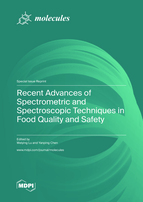Recent Advances of Spectrometric and Spectroscopic Techniques in Food Quality and Safety
A special issue of Molecules (ISSN 1420-3049). This special issue belongs to the section "Analytical Chemistry".
Deadline for manuscript submissions: closed (31 December 2022) | Viewed by 28076
Special Issue Editors
Interests: sensors; food analysis; proteomics; nontargeted detection; chemometrics
Special Issues, Collections and Topics in MDPI journals
Interests: food flavor; biosensors; flavor chemistry; sensory evaluation
Special Issues, Collections and Topics in MDPI journals
Special Issue Information
Dear Colleagues,
Spectrometric and spectroscopic techniques, including mass spectrometry, infrared and Raman spectroscopy, ion mobility spectrometry, differential mobility spectrometry, etc., are the major techniques for the study of food quality and safety nowadays. They are ideal and versatile tools in the evaluation of functional components, such as proteins and lipids, as well as key components related to food safety, such as pesticide residues, pollutants, authentication, and illicit adulterants. Spectrometry and spectroscopy is also the cornerstone of many modern biochemical techniques, such as proteomics and metabolomics.
This Special Issue will introduce recent advances of spectrometric and spectroscopic techniques in food quality and safety evaluations, explorations, and prospects the future application trends. Topics including, but not limited to, novel sample preprocessing methods, probing, ambient ionization (DART, DESI), structure elucidation, database searching, hyphenation (GC×GC-MS, LC×LC-MS, IMS-MS, etc.), chemometrics/nontargeted identification using spectrometric and spectroscopic techniques. Topics related to the application of spectrometric and spectroscopic techniques, such as in biosensors and hyperspectral imaging innovation would also be suitable.
Dr. Weiying Lu
Dr. Yanping Chen
Guest Editors
Manuscript Submission Information
Manuscripts should be submitted online at www.mdpi.com by registering and logging in to this website. Once you are registered, click here to go to the submission form. Manuscripts can be submitted until the deadline. All submissions that pass pre-check are peer-reviewed. Accepted papers will be published continuously in the journal (as soon as accepted) and will be listed together on the special issue website. Research articles, review articles as well as short communications are invited. For planned papers, a title and short abstract (about 100 words) can be sent to the Editorial Office for announcement on this website.
Submitted manuscripts should not have been published previously, nor be under consideration for publication elsewhere (except conference proceedings papers). All manuscripts are thoroughly refereed through a single-blind peer-review process. A guide for authors and other relevant information for submission of manuscripts is available on the Instructions for Authors page. Molecules is an international peer-reviewed open access semimonthly journal published by MDPI.
Please visit the Instructions for Authors page before submitting a manuscript. The Article Processing Charge (APC) for publication in this open access journal is 2700 CHF (Swiss Francs). Submitted papers should be well formatted and use good English. Authors may use MDPI's English editing service prior to publication or during author revisions.
Keywords
- food quality
- food safety
- mass spectrometry
- infrared spectroscopy
- raman spectroscopy
- hyperspectral imaging
- ion-mobility spectrometry
- differential-mobility spectrometry








